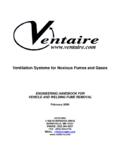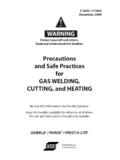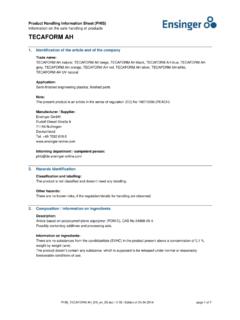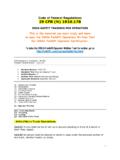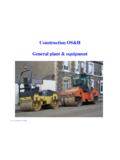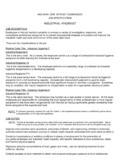Transcription of Indoor air quality legislation in South Africa - ISIAQ
1 Indoor AIR quality legislation IN South Africa J Gansan1*, N Gqaleni1 and JE Ehiri2 1 Africa Centre for Indoor Air quality , Nelson R Mandela School of Medicine, University of Natal, South Africa . 2 Department of International Health, Liverpool School of Tropical Medicine, ABSTRACT This paper assesses legislation in South Africa with respect to Indoor air quality . It indicates that, although there is no specific law and comprehensive policy that deals, specifically with Indoor air quality , there are several acts of parliament that safeguard health and address specific health matters, in which Indoor air quality does not feature prominently.
2 The paper will describe the role of the Constitution, Health Act, Atmospheric Pollution Prevention Act, Housing Act, Occupational Health and Safety Act as well as the National Building Regulations in making provisions for better Indoor air quality . INDEX TERMS Indoor air quality , legislation , Health, South Africa INTRODUCTION The right to breath healthy Indoor air is one of the many principals formulated by the World Health Organisation (WHO, 2000). This is because the quality of Indoor air that one breathes directly affects the health and well-being and also has a bearing on the quality of life and life-style one enjoys.
3 However, the control of Indoor air quality is often inadequate. Most exposure to Indoor air occurs in private homes, where interventions by public regulations is often considered a violation of personal freedom (WHO, 2000). To a large extent, the inadequate quality of Indoor air arises from a poor articulation, appreciation and understanding of the policies related to Indoor air quality . Poor building design, construction, materials and maintenance as well as ambient conditions, creates Indoor microclimates in which various biocontaminants including fungi are able to proliferate (Singh, 1994). * Contact author email: A study on Indoor air quality in a shack settlement in Durban, South Africa , showed that acute respiratory illnesses (ARIs), accounted for the high incidence rates on children (Danaviah et al, 2000).
4 Amongst the risk factors for ARIs were family size, overcrowding, poor sanitation, malnutrition and exposure to poor Indoor air, typical to shack settlements (Danaviah et al, 2000). Approximately 30 % of the paediatric admissions in some of Durban hospitals are due to asthma (Danaviah et al, 2000), as compared with an estimated 20 - 25 % incidence rate worldwide (Phelan et al, 1990). Children are becoming the main focus in this risk area, as they exclude the confounding effects of smoking and occupational exposure to allergens. They would additionally experience more acute manifestation of a disease condition due to their size and underdeveloped immune systems.
5 ARIs present the most alarming statistics: one infant death every seven seconds and four and a half million deaths annually in developing countries (Berman, 1991). Awareness of the health significance of good Indoor air quality is low in many societies Proceedings: Indoor Air 2002655mainly because of sufficient information is not available to those affected. The laws protecting people from harmful exposures indoors are less developed, which potentially increases inequalities in health and aggravates health risks in the less informed, poorer parts of the society and amongst the most vulnerable groups.
6 The question is how does government protect the communities and the workers? This paper is aimed at assessing Indoor air quality legislation in South Africa in the context of health protection. THE HEALTH ACT NO. 63 OF 1977 The Constitution of South Africa is the basis of law and legislation in the country. Chapter 2 of the constitution states that, everyone in South Africa has the right to live and work in an environment that is not harmful to their health and well-being. The World Health organisation (WHO) is also in agreement with right as per their principals (WHO, 2000). The aim of the Health Act is to provide for measures for the promotion of the health of the inhabitants of the republic; to that end to provide for the rendering of Health Services; to define the duties, powers and responsibilities of certain authorities which render health services in the Republic; to provide for the co-ordination of such health services; and to provide for incidental matters.
7 The Health Act deals with the many regulations put in place in terms of medical conditions, communicable disease, and conditions dangerous to health. There is more emphasis placed on food, milk and water as conditions that are dangerous to health than air, which is an equally important necessity to everyone. Chapter 5 of the Act makes provision for notifiable medical conditions relating to communicable diseases, mode of transmission by the various vectors and unhygienic conditions as sources of infections. The Act vaguely mentions dwellings, over-crowding, and poorly ventilated design as a source of dangers to health, (Regulation 34), which is related to air quality .
8 THE ATMOSPHERIC POLLUTION PREVENTION ACT 45 OF 1965 This legislation primarily focuses on Air Pollution in the forms of smoke, dust and vehicle emissions. Smoke emissions relate only to boiler systems and heating appliances and is focused to industrial and occupational applications and not to the residential set-up. It is a right of every person to enjoy good Indoor air, be it in residential settings or within work environments, which is not provided for in this act. The external environment and its impact by pollution generated from industries, dwellings, locomotives is dealt with and not the conditions and impact suffered interiorly.
9 This legislation is also fairly old and requires updating in accordance to the changes and demands of the country. The Act comprises of 5 parts, summarised as follows: - Part 1: The National Air Pollution Advisory Committee - its formulation and functions. Part 2: Control of Noxious or offensive gases - where the government designates controlled area, and authorise scheduled processes. This part does not deal with Indoor air quality , as it focuses on industrial and occupational. Part 3: Atmospheric Pollution by Smoke - function delegated to the Local Authority. This Part also deals with industries, however Section 14 makes provision for fuel burning appliances in dwellings, and the use of fuels (18,d).
10 Part 4: Dust control - in Mines Part 5: Air Pollution by fumes emitted by Motor Vehicles Part 6: General provisions of the act. Proceedings: Indoor Air 2002656 There are several important aspects that are construed as weakness to the Act: - Smoke control regulations should apply to residential areas, in particular low-income communities who tend to live in close proximity to large industrial settings. - Provisions should be made to control volatile organic compounds and fugitive emissions - Complaints about dust are always referred to the Local Authority who has no powers to control dust. - There is no air quality standard that has been set nor any consideration made to health and environmental impacts.

